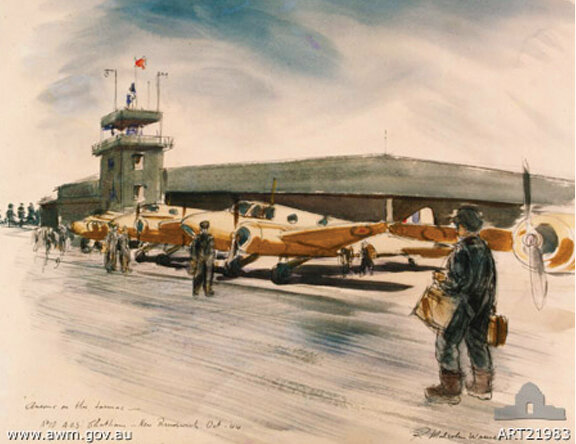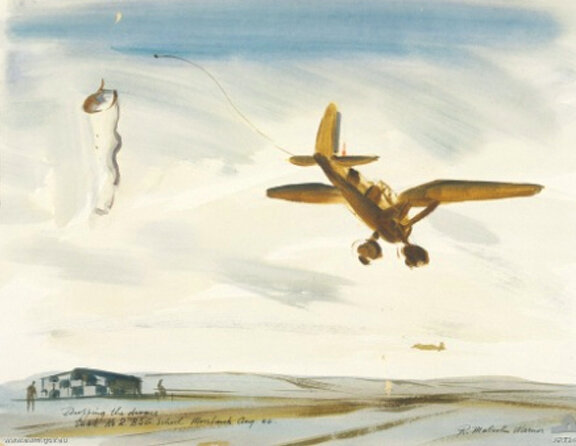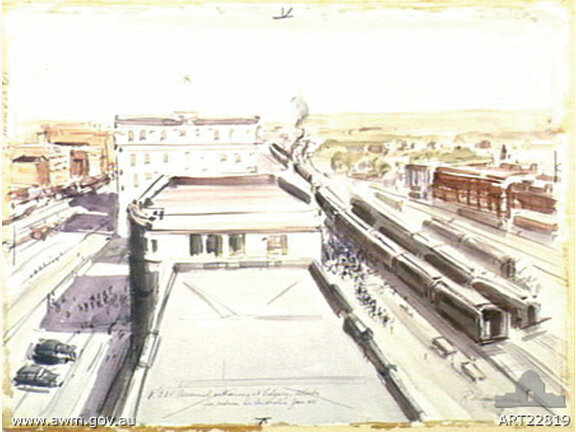THE BCATP IN WATERCOLOUR
While scrambling through the internet this past month in search of relevant images for last week's story on the filming of “Captains of the Clouds” I discovered a wonderful place and an amazing set of images that need to be shared with our readership.
The virtual place is the website of the Australian War Memorial, the repository of images, stories, documents and memories of our antipodal brother "colony" set in the sparkling waters of the Indian and Pacific Oceans. There I stumbled across the above watercolour sketch of Avro Ansons flying above the blazing autumn colours of Québec's Laurentian Hills. It was exquisite and a revelation for I had never seen the workaday nature of the BCATP portrayed in any manner other than photographs or strident propaganda posters.
The artist was Captain Ralph Malcolm Warner, one of Australia's official war artists, sent to cover the Australian experience in Canada as RAAF men learned to fly, navigate, shoot and fight at the Aerodrome of Democracy - the British Commonwealth Air Training Plan. Warner crisscrossed the vastness of our country sketching and painting what he saw and turning out a remarkable series of watercolour and ink pieces that speak of Canadian experience through Aussie eyes. Warner's visual sense and palette of colours seem born from the sun-bleached outback, but yet they work here remarkably for they speak Aussie. And it was indeed the Aussie perspective that was his goal.
Looking at the dates and places where these paintings were done, it is evident that Warner was on the move with the benefit of transportation provided by the hundreds of BCATP aircraft flitting about the land delivering staff, students and themselves. He covered the entire landscape from Nova Scotia to Alberta and was also tasked to cover Australians in the Bahamas and in the United States.
Warner was born in Geelong, Victoria and studied art there and in Melbourne and Sydney. Like me, he was a commercial and advertising artist. He was called up for service and his artistic training was put to great use. He first was a camouflage painter then a designer of propaganda posters, but his obvious abilities were of a higher caliber and soon he was chosen for the highest calling for an artist in the service of his country - an official war artist.
After a brief visit to Papua New Guinea, he shipped to Canada where, over a period of 6 months, he visited 24 training schools as well as other facilities related to the experience. What follows is a unique visualization of one of the most important episodes of Canada's aviation and military history captured in the powerful and controlled brush strokes of a man from the antipodes.
His style had to be adapted as extreme weather (not for a Canadian), busy training schedules and constant movement meant he had to do rough and fast sketches on the spot and then create the finished works in barracks and hotel rooms after the fact. The fully-worked pieces still feel sketchy and quick, but the warmth, openness and sense of momentous events to come make these a wonderful record of Australians learning the skills that will put them to the test, put them in harm's way and possibly put them in the ground.
The Australian War Memorial allows not-for-profit organizations like Vintage Wings of Canada to use the images for educational purposes, so we present them here for your enjoyment. It is required that the watermarks should not be removed and the resolution and quality of the scans probably leave a lot of detail and colour back at the AWM, but still they sing out loud. A tribute to a great war artist. Throughout the description from the AWM, the British Commonwealth Air Training Plan (BCATP) is referred to by its older title, the Empire Air Training Scheme (EATS) but I have employed the one commonly used here in Canada.
Vintage Wings of Canada would like to thank the Australian War Memorial firstly for allowing these images to be used for non-profit educational use, but most importantly for taking such care of these wonderful paintings which are an artistic record of a shared experience.
The Watercolours
On a cold and gray October day in 1944 at Chatham, New Brunswick, Warner painted this sketch of crews readying for a day’s flying in Avro Ansons of No 10 Air Observers' School. The red flag on the control tower indicates left hand circuits will be flown on this day. Image from the Australian War Memorial.
In December of ‘44, Warner had crossed back across half the country to no doubt enjoy the charms of a Manitoba winter. This remarkably simple and moody sketch of BCATP’s No. 3 Wireless School at Winnipeg shows his architectural appreciation, while the depiction of snow on the roof and gables is pure and very well executed for a man who knew no snow growing up. Image from the Australian War Memorial.
Related Stories
Click on image
In August of 1944, Warner was at No. 3 Service Flying Training School in Calgary, Alberta. In this sketch he manages to work in the Rocky Mountains which would have made a powerful impact on Royal Australian Air Force pilots who trained there. Image from the Australian War Memorial.
Warner was on a visit to the maritime provinces in the fall of 1944. Here in Nova Scotia at No. 8 Operation Training Unit he depicts multi-engine pilots undergoing night flying training with searchlights operated by members of the RAAF. Image from the Australian War Memorial.
Warner’s remarkable record in watercolour, ink, pen. charcoal and pencil is outstanding in that it captures the steady work and determination of the BCATP in all its aspects. In Saskatchewan in 1944, he sketched this dramatic depiction of an indoor hemispheric training aid for aerial gunners. The device employed moving pictures of aircraft that were projected onto the concave surface of the hemisphere. The gunner's aim was checked by the projection of a target as the trigger was depressed. This training facility was the No 2 Bombing and Gunnery School, Mossbank, Saskatchewan. Image from the Australian War Memorial.
Still at Mossbank on the open Saskatchewan prairie in the summer of 1944, a Westland Lysander built in Canada drops a target drogue after aerial gunnery practice at No.2 Bombing and Gunnery School. Judging by the bullet holes the student was successful. Vintage Wings of Canada’s Lysander is presently painted in the same distinctive yellow and black paint scheme - known as the “Oxydol” scheme after the packaging of a well known laundry detergent available in Canada. Image from the Australian War Memorial.
In September of 1944, Warner was in Manitoba where he captured these Avro Anson aircraft outrunning an oncoming fog bank (those aren’t mountains, there are no mountains in Manitoba). Warner’s notes accompanying the image indicate that the weather at the time was cold and wet - an indication of how uncomfortable he must have been, flying in the lead Anson. Image from the Australian War Memorial.
This loose watercolour and ink sketch shows Hawker Hurricanes (Canadian-built) flying over the autumn colours of a Quebec landscape along the Saguenay River, 1944. This would have been at the No.1 Operational Training Unit at Bagotville, Québec. Today the facility is still an operational fighter base housing 433 and 425 Squadrons of the Canadian Air Force. Image from the Australian War Memorial.
Every aspect of the BCATP experience for the Australian aviator was of interest to the RAAF and to Ralph Warner. The dark gray skies over the old “Y” Depot in Halifax, Nova Scotia give this embarkation point for graduates of the BCATP the air of a concentration camp. From this place, RAAF fliers as well others from the Commonwealth awaited the ships that would take them to the war. Image from the Australian War Memorial.
Avro Ansons from No. 2 Air Navigation School at Charlottetown, Prince Edward Island, climb steadily on a navigation training flight as the sun rises over the island. Warner’s ability to capture the landscapes and make them clearly identifiable makes his work very appealing to Canadians and Australians alike. Image from the Australian War Memorial.
The line of hangars at No.8 Operational Training Unit at Greenwood, Nova Scotia. These hangars would have been crammed with Bristol Bolingbrokes, North American Harvards, Lockheed Hudsons, de Havilland Mosquitos, and Airspeed Oxfords. Image from The Australian War Memorial
Once again in the fall of 1944, Warner paints an image of Anson aircraft overflying the Laurentians in fall. Remove the airplanes and the painting becomes very much like landscapes of the Group of Seven. Image from the Australian War Memorial.
In an almost postcard-like framing, Warner finds two RAAF flyers on leave and playing golf at the beautiful course at the world famous railroad hotel at Banff Springs. Required to capture the full extent of the Australian experience on the Canadian landscape Warner “had” to paint these moments. While certainly important, one could hardly call this war. This grand hotel set in the rugged wilderness of one of Canada’s Premier National Parks must have had a profound effect on the boys from the outback. Image from the Australian War Memorial.
Hawker Hurricane XIIs practice a scramble in a training exercise at No. 32 (later No. 8) Operational Training Unit at Greenwood in Nova Scotia’s Annapolis Valley. BCATP graduates were sent to OTUs to get advanced training on operational types such as the Hurricane. Many of these OTU’s were overseas in Great Britain, but there were a number of the bases here in Canada. Image from the Australian War Memorial.
An Avro Anson lumbers into the big Manitoba sky from the runways of the Central Navigation School where already graduated navigators were trained to be instructors. The haystacks and barn give viewers a sense of how bucolic were the settings of most of these places - on remote flat plains with big, big sky above - room to fly, to mess up and come home safe and room to hone one’s warcraft. Image from the Australian War Memorial.
No prolonged stay in Canada would be complete without an attempt at ice hockey, the national passion. Here Warner shows us a group of Australian aviators enjoying their first experience on skates. The fellow in the red and blue toque and scarf seems like he may be a tad more experienced than the other lads who seem to either be on their butts or well on their way to landing on them. It’s a guess he’s Canadian and possibly a Montreal Canadiens fan. Warner gives us no hint of the location in his notes, but as all Canucks know... this can be Anywhere, Canada. Image from the Australian War Memorial.
August 1944. No.2 Wireless School on the Alberta plains was housed in a college building both the Alberta Normal School (teachers college) and a technical college. After the war it returned to these civilian duties. No.2 also employed Fleet Fort and Harvard aircraft for aerial instruction. Image from the Australian War Memorial.
September 1944. A pair of Harvards from No. 6 SFTS at Dunnville, Ontario overfly the outskirts of St. Catharine’s while on a cross country training flight in wet weather - possibly after or before the storm depicted in the next painting by Warner. Image from the Australian War Memorial.
Not all flying days were good flying days. Here a pair of Harvards wait out a severe autumn storm at Dunnville, Ontario in 1944. Image from the Australian War Memorial
Warner’s painting of landscapes usually depicted them as backdrops for the flying of aircraft, but once in a while he simply painted the remarkable view afforded Aussie aviators from their aircraft. Here he paints the New Brunswick coastline from an airplane flying out of No. 8 OTU at Greenwood, Nova Scotia. October, 1944. Image from the Australian War Memorial.
The AWM caption with this painting is most likely incorrect in that it says it is Saskatchewan in sub-zero weather. Most likely it is of a de Havilland Mosquito diving off the coast of Nova Scotia in October of 1944. No. 8 OTU at Greenwood was the only BCATP training base to operate the Mossie. Image from the Australian War Memorial.
January 1945 and going home. Royal Australian Air Force graduates of the British Commonwealth Air Training Plan board Canadian Pacific Railroad coaches at Calgary for the return trip to Australia. It’s January in Calgary and you can bet these lads just want to get the hell out of there and get back to the sun and warmth of Australia - can’t blame them at all. Image from the Australian War Memorial.





























